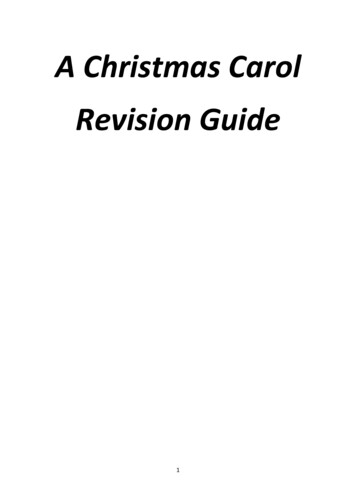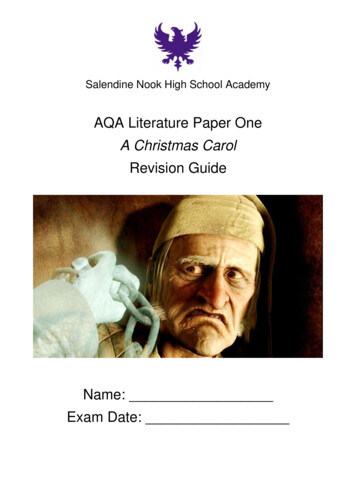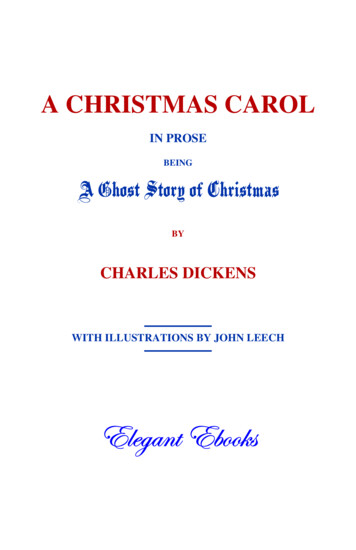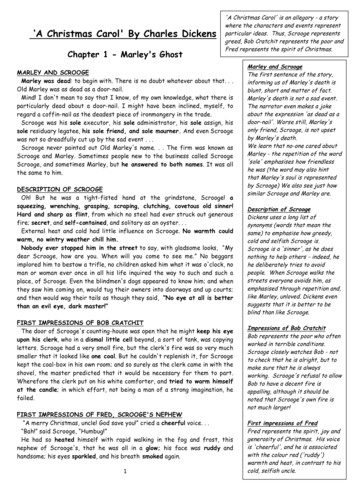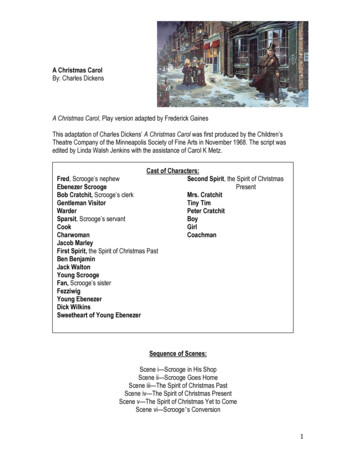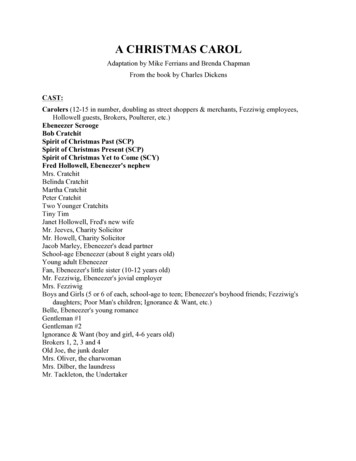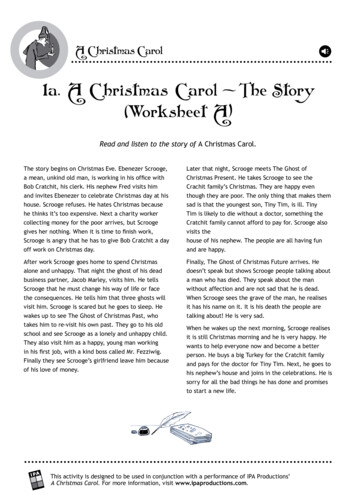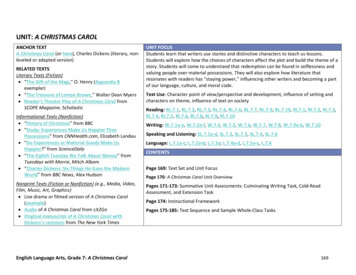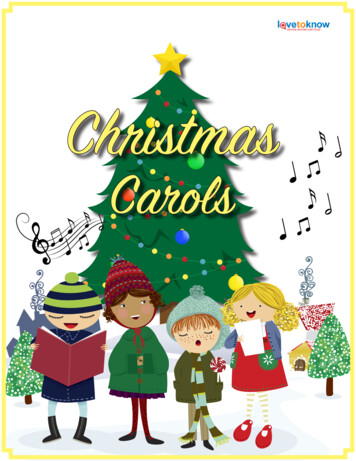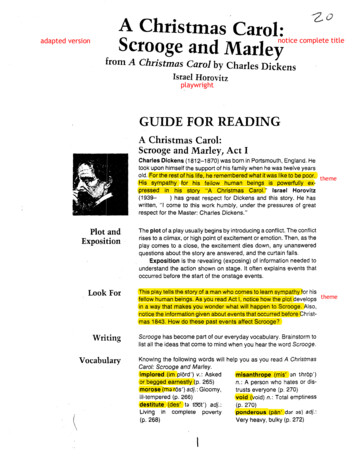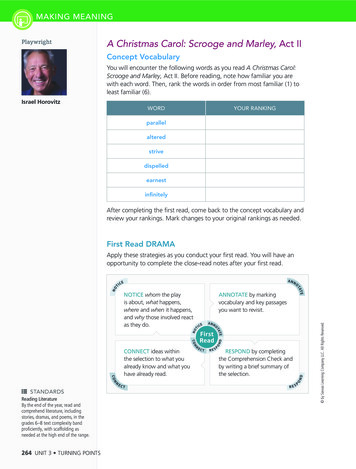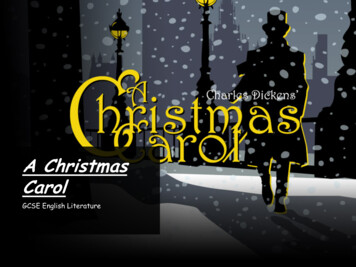
Transcription
A ChristmasCarolGCSE English Literature
What youneed todo Answer the extract question andone essay for BOTH of your settexts.Timings:20 minutes40 minutes20 minutes40 minutes
ContextPublished in 1843.Dickens knew what life was like for the poor.He believed in the celebration of Christmas.Through Scrooge, Dickens criticises thePoor Law (1834) – the requirement for harshworkhouses to be set up to take the poor inevery parish. Remember that in Stave 1 Scrooge wants toknow if the ‘Union workhouses’, ‘Treadmill’and ‘Poor Law’ are still in ‘full vigour’. High child death rates. Lots of poverty.
Context Social class divide the IndustrialRevolution made many businessmen andfactory owners extremely rich. It alsocreated huge numbers of new jobs in thecities. However, the factory workers oftenlived in extreme poverty. Cities – terrible living conditions – millionsof people moved from the country to thecity in search of factory work. People ended up living in slums/cheapovercrowded housing. No properdrainage/sewage systems/many familiesforced to share one tap and one toilet.
Context Dickens was interested in the plight of thepoor – link to his own childhood experienceof poverty when his family went into debt. He wrote the novella to highlight theissues in society. He wanted to addressthe poverty in Britain. He believed education was the solution topoverty.
Scrooge Begins as mean, cold-hearted and callous(‘tight-fisted’ ‘old sinner’ ‘hard and sharp asflint’) His bitterness even influences the weather‘carried his own low temperature’‘External heat and cold had little influenceon Scrooge’. Scrooge has no friends – ‘solitary as anoyster.’ He is completely isolated at the start.
Scrooge’s behaviour in Stave 1 He is rude to Fred and cruel towardsBob. Scrooge is horrid towards the CharityCollectors. ‘Are there no prisons?’ They want to ‘buy the Poor some meatand drink’ when ‘Want is keenly felt’. ‘they had better do it, and decrease thesurplus population’ He ‘seized the ruler’ when the carolsinger tried to sing!
ScroogeandMarley’sGhost(Stave1) The tail is made of ‘cash-boxes,keys, padlocks’ etc. He feels the ‘chilling influence’. ‘There’s more of gravy than ofgrave about you’ – shows he istrying to dismiss it. ‘dismal and appalling noise’ ‘Dreadful apparition,’ saidScrooge. ‘I wear the chain I forged in life’(Marley) ‘Speak comfort to me, Jacob’ ‘I have none to give’ Marley’s Ghost has had ‘no rest,no peace.’
Scrooge in Stave 2 We learn details about his earlier life andthey help us to understand that he isn’tcompletely bad. He is a character who is damaged andfearful. As we see Scrooge responding to eventsfrom his younger days, we gradually see thathe is far from an evil character and oursympathy builds. His emotions start to develop.
“I was bred in this place. I was a boy here!” “Your lip is trembling,” said the Ghost. ‘And what is thatupon your cheek?” ‘Scrooge muttered, with an unusual catching in his voice,that it was a pimple’ “A solitary child, neglected by his friends, is left therestill.” ‘Scrooge said he knew it. And he sobbed.’ ‘At one of these a lonely boy was reading near a feeblefire; and Scrooge sat down upon a form, and wept to seehis poor forgotten self as he had used to be.’ ‘but fell upon the heart of Scrooge with a softeninginfluence, and gave a freer passage to his tears.’ “There was a boy singing a Christmas Carol at my doorlast night. I should like to have given him something:that's all.” “No. I should like to be able to say a word or two to myclerk just now! That's all.”
Key Quotes for Scrooge ‘solitary’‘neglected’‘and he sobbed’‘after drying his eyes with his cuff’‘There was a boy singing a ChristmasCarol at my door last night. I should liketo have given him something: that’s all.’
Fezziwig He skips with ‘wonderfulagility’. He threw parties andeveryone was invited. Fezziwig offers a contrastto Scrooge in that he canshare with others, eventhough the party doesn’tcost that much. Fezziwig is like a childduring the festive season. Dickens thought thatChristmas was aboutbringing everybodytogether, just like atFezziwig’s party / ball. The celebration would havebrought a lot of joy.
Scrooge (end of Stave 2) Money caused Scrooge and Belle’srelationship to end. Scrooge says that the spirit takes‘delight’ in the ‘torture’ he is putting himthrough. The spirit takes Scrooge to see Belleand her husband (happy family).
Stave 2Think about the fact that he regrets hisbehaviour towards the singer, Fred andBob in this Stave.He is able to redeem himself in the Stave5 by being generous and good to thecharity collectors, Fred, and the boy.
Stave 3: The Ghost of Christmas Present ‘jolly Giant, glorious to see’ ‘who bore a glowing torch’, ‘It was clothed in one simple deep green robe bordered with white fur.’ ‘Its dark brown curls were long and free: freeas its genial face, its sparkling eye, its openhand, its cheery voice, its unconstraineddemeanour, and its joyful air.’ “If these shadows remain unaltered by theFuture, none other of my race,” returned theGhost, “will find him here. What then? If hebe like to die, he had better do it, anddecrease the surplus population.” – WHEN HEASKS IF TINY TIM WILL LIVE.
Scrooge in Stave Three We learn about how Christmas is celebratedin different places, and by different people. Scrooge’s room has ‘undergone a surprisingtransformation’ (p.41). There is a ‘mightyblaze’ burning in the fireplace and the placeis full of food and decorations. They move to the city streets on Christmasmorning, where the weather is severe, butthe people are still jolly, highlighting thecommunity spirit in amongst the snow andthe dirt from the factories. Scrooge is being taught by the ghost.
Scrooge sees the Cratchitfamily They make themost out of whatthey’ve got. ‘brave in ribbons’ Dickens showshow you made themost of what youhad. Tiny Tim (‘activelittle crutch’ and‘limbs supportedby an iron frame’)
Christmas in the Country The Ghost shows Scrooge a family ofminers celebrating Christmas with goodcheer. Two lighthouse keepers, who are isolated,share some of the spirit of the season. A ship, far from the shore, contains menwho are full of Christmas thoughts. THE SCENES SHOW THAT THE PEOPLEARE FULL OF HOPE AT CHRISTMAS. THEY CAPTURE WHAT DICKENSTHOUGHT CHRISTMAS SHOULD HAVEBEEN ABOUT.
Christmas at Fred’s Scrooge’s nephew, Fred, and his familyare having fun at Christmas. They discuss Scrooge and decide thatthe only person he harms by being meanis himself. Scrooge joins in with the games theyplay although they cannot see or hearhim. Fred is still cheerful and merry.
Ignorance andWant The Ghost shows Scroogetwo children calledIgnorance (boy) and Want(girl).They are the children ofthe society in whichScrooge lives.The Ghost says both arebad, but Ignorance is moredangerous than Want.There is a change at thispoint and we are meant totake notice.Scrooge’s own ignorance hascreated want.
Scrooge in Stave Four Scrooge has changed, even before he isexposed to what the Ghost of Christmas Yetto Come has in store for him. ‘Scrooge feared the silent shape so much’ ‘I hope to live to be another man from what Iwas’ (p.66) Scrooge’s own death is foreshadowed(predicted), but nobody seems to care thathe has died. People steal from him and it highlights howcrime was on the increase.
Scrooge The businessmen are cruel about the ‘deadman’ – ‘I thought he’d never die.’ The men are interested in what they willget. We see the bad side to London – ‘foul’,‘reeked with crime, with filth, and misery.’ The people in the shop show Scrooge hadnobody: ‘why wasn’t he natural in hislifetime?’ A young woman and her husband are happyhe is dead – this is the emotion he sees. Scrooge is appalled. ‘Let me see some tenderness connectedwith a death’
They go to ‘poor Bob Cratchit’s house’ ‘Quiet. Very quiet.’ ‘The noisy little Cratchits were as stillas statues’ ‘My little, little child!’ ‘Tell me what man that was whom we sawlying dead?’ The ‘wretched man’ has a grave ‘overrunby grass and weeds.’
Scrooge ‘neglected grave’ ‘ “Am I that man wholay upon the bed?” hecried, upon his knees.’ “I am not the man Iwas.” “I will honourChristmas in myheart, and try tokeep it all year. I willlive in the Past, thePresent, and theFuture.” (repeatedright at the start ofStave Five) “I will not shut outthe lessons that theyteach”
Stave Five:The changein Scrooge ‘fluttered’‘glowing with hisgood intentions’‘laughing’‘I am as happy asan angel’‘I am as merry as aschoolboy’‘I am as giddy as adrunken man’‘No fog, no mist;clear, bright’‘chuckle’
Bob Cratchit A hard working and caringfamily man ‘white comforter’ He ‘boasted no great coat’. He can’t object to the wayhe’s treated by Scroogebecause he is loyal to him andhe’s grateful for the moneyhe earns. He represents the lowerclasses and he has no choicebut to accept the poor wagesand working conditionsbecause he has a family tosupport and a badly-paid jobis better than no job at all.
Bob Cratchit His good nature is his main characteristic,as seen when he toasts Scrooge as ‘theFounder of the Feast’ in Stave Three. Bob is cheery and grateful for what hehas, despite his hardship. Family ties were very important during the19th century and Bob highlights theimportance of love. Bob’s great love for his family is a sharpcontrast to Scrooge’s miserly nature andthe fact that he is unwilling to engage withhis one surviving relative, Fred.
Bob Cratchit Bob is gentle with his son, Tiny Tim. His love for the boy is evident in thatthey go everywhere together when Bobis not working, and Bob carries Tim onhis shoulder, running all the way homefrom church with him. ‘as good as gold’ Bob understands the wisdom ofchildren, showing that he can learn fromhis son when he says that Tim has toldhim that he hopes the church-goers willsee he’s a cripple.
Bob Cratchit Bob can be seen as truly heroic becauseof the way in which he mourns Tiny Tim. Dickens highlights child mortality(death) and how it was an unpleasantreality across all classes in VictorianBritain, but it had a particular impact onthe poor, who suffered frommalnourishment and poor livingconditions. In the vision of Christmas Yet to Come,Bob shows his true strength ofcharacter through his grief-strickenacceptance of Tim’s death.
Bob Cratchit Although the whole family feels the lossof Tim, Bob seems to miss his constantcompanion more than any of the otherCratchits, breaking down and sobbing,‘My little, little child!’ In spite of his despair, Bob takescomfort in his surviving family membersand once again tries to learn from Tim. Bob doesn’t give in to misery and drawscourage from Tim’s memory instead anduses this to bind his family together.
Bob and Scrooge Bob and Scrooge are at opposite moralpoles and it’s clear that Dickens wants usto compare their lives. Scrooge is wealthyand isolated, whereas Bob is happy in spiteof his poverty. Scrooge takes his meals in solitude, butBob light-heartedly flings himself downthe ice slide on Cornhill ‘twenty times’before racing home to play blind man'sbuff with his family. Scrooge’s world is defined by work andmaterial gain, while Bob is able to balancework with cheer. Bob is like a child when heleaves work for Christmas and Dickenslinks childish qualities to Christmas cheer.
Fred Scrooge’s nephew and the only son ofScrooge’s much loved sister, Fan. Along with Fan, he is the only other person wesee treating Scrooge with love in the novella. He is the antithesis of Scrooge,demonstrating how we should behave towardsone another. Fred acts as a foil to the hardened ScroogeHe is someone with the opposite characteristics toScrooge. He is used to balance Scrooge out and drawattention to his failings.
Fred (Stave 1) He is able to stand his ground againstScrooge in Stave 1. He values love over money. He is the voice for Dickens’ views as hedefines Christmas as: ‘a good time; akind forgiving, charitable, pleasanttime.’ He wishes his uncle a ‘Merry Christmas’several times.
Fred (Stave 3) He shows us that Scrooge is to bepitied: ‘I am sorry for him; I couldn’t beangry with him if I tried. Who suffersby his ill whims? Himself, always. Fred is thoughtful and this is a typicalapproach of his character.
Fred (Stave 3) He is defined by his good humour andlaughter: ‘Scrooge’s nephew revelled inanother laugh.’ The verb ‘revelled’ suggests hisenjoyment of laughter. It displays hisvery positive approach to life.
Fred (Stave 5) He accepts the changed Scrooge withoutquestion. ‘Let him in! It is a mercy he didn’t shakehis arm off.’ Fred accepts somebody at face value anddoes not question the change in Scrooge’scharacter. He is very trusting and is aperfect representation of goodness, loveand kindness in the text.
Show how Dickens presents the hardships of lifein 19th century London in A Christmas Carol. Link this to the context and the conditions during the time of AChristmas Carol. Remember that Dickens believed the poorsuffered unfairly. Explore Scrooge’s attitude towards the collectors and carol singerin Stave 1. Explore the Cratchit family and what we learn about the povertythey live in. Dickens felt the suffering of the poor children duringthe time of the nineteenth century (Tiny Tim). Explore the inclusion of ‘Ignorance’ and ‘Want’ and what theyrepresent within the text. You could also consider how Scrooge’s ignorance has created wantwithin the Cratchit family, as well as any others he has dealt with. Explore what is revealed in Stave 4 by the Ghost of Christmas Yetto Come and the condition of London (dirty, dank, horrible, crime). Conclude with anything thoughtful about Dickens’ intentions interms of the theme.
What are Dickens’ moralmessages in A Christmas Carol?You could consider: the presentation of Scrooge and how hechanges; what Dickens thought about how povertywas dealt with at the time; how he presents suffering in differentparts of the story; how he uses particular people or childrento highlight / reinforce his message. how Scrooge changes.
Horror in A Christmas Carol- The use of the way in which Marley'sGhost becomes a vision of horror in Stave1 (Marley's Ghost is very important - onlyfriend Scrooge had - had to be this ghostfirst).- Scrooge's own horror at seeing his formerself in Stave 2 and the events which upsethim.- The inclusion of Ignorance and Want.- The use of the 'Phantom' in Stave 4 andhow it is described and what it reveals toScrooge (unpleasant treatment fromothers, London, the way people react tothe death of the man (Scrooge), death ofTiny Tim, Scrooge seeing his grave.
Childhood in A Christmas Carol Consider Scrooge’s attitude to the carolsinger in Stave 1. Scrooge’s own childhood in Stave 2. Stave 3: Tiny Tim and Ignorance andWant Stave 4: The ‘death’ of Tiny Tim. Stave 5: Scrooge becomes like a childhimself!
Christmas (Stave 1) Scrooge rejects Christmas; Fredembraces it. Scrooge dismisses the men who arecollecting for charity. Even through the fog and darkness inthe city, the Christmas spirit breaksthrough. Bob wants to celebrate with his family.
Christmas (Stave 2 and Stave 3)Stave 2 Scrooge was left alone! Scrooge regrets his previous behaviourin Stave 1. Fezziwig is there to highlight howScrooge should behave now. Stave 3: The ghost teaches him aboutChristmas (Cratchits, people in difficultconditions, Fred).
Christmas (Stave 5) Scrooge wakes on Christmas Day and findseverything as he left it the night before. He isoverwhelmed at having a chance to changethings. He delights in everything he sees. He arranges for a prize turkey to be sent tothe Cratchit household. On his way to church, he makes a large donationto charity (think about change and redemption).
Change Scrooge has to be presented negatively inStave 1 for us to recognise (and accept)him in Stave 5. Stave 2: We see how Scrooge becomesemotional. Stave 3: He is affected by seeing theCratchits and Tiny Tim. He is deeplydisturbed by the appearance of Ignoranceand Want. Stave 4: Think about his reaction to otherpeople (businessman, the young couple). Heis very affected by Tiny Tim’s death.
Change The ghosts play a significant role inScrooge’s changing character. The phantom takes Scrooge to his gravein Stave 4 and this horrifies him.Remember that he cries upon his knees. He is described as being ‘in agony.’ He wants to live in ‘the Past, thePresent and the Future.’ Stave 5: Scrooge is transformed!
Goodness / Love / Kindness / Carein A Christmas Carol Dickens highlights that goodness and love overcome greedand selfishness. He highlights how the poor needed people to showgoodness and love towards them during Victorian times. Stave 1: Scrooge is presented as lacking in goodness andlove at the start of the novella – dismisses his own nephew,as well as the charity collectors and the carol singer. Hetreats Bob like a prisoner when he should be caring forhim. Marley’s Ghost highlights how he there is ‘incessanttorture of remorse’ in the afterlife and he says: ‘I wearthe chain I forged in life.’ Marley is emphasising how heshould have demonstrated care and love for others whenhe was alive. Stave 2: The Ghost of Christmas Past – shows Scroogehow he used to be and how he changed as a person – herejected love because of his own self-interest. Fezziwig – kind and welcoming – involves everyone –caring/generous.
Goodness / Love / Kindness /Care Stave 3: Consider Bob and the way he treatsothers – respect for Scrooge / looks after hisfamily. The Cratchit family (Tiny Tim) Fred and his friends and family in Stave 3 –pities Scrooge / they laugh at him – but he stillinvited him over in Stave 1 and has him there inStave 5. The change in Scrooge throughout the book –concern for Tiny Tim, doesn’t like to seebehaviour of others in Stave 4, changescompletely in Stave 5.
Religion Victorian society was very religious. Christianity had a strong influence onmany areas of everyday life in VictorianBritain, particularly amongst the middleand upper classes. To be good Christians, people believedthey should live by a strict moral code –attending church regularly.
Dickens and Religion His view of Christianity was different –he believed that to be a good Christian,people should seek out opportunities todo good deeds for other people. He thought that people should behumble, charitable, faithful andforgiving, rather than merely appearingreligious.
Religion and Context It was a widespread Victorian practice tospend Sunday going to church and resting –known as Sabbatarianism. Dickens was opposed to this because itmeant that working poorer people weredenied any enjoyment on their day off –everything was shut. Many poorer people didn’t have ovens athome, so they often had food cooked bybakers. Sabbatarianism meant that manypeople couldn’t get a hot meal on Sundaysbecause the bakers were shut.
Christmas in the Country The Ghost shows Scrooge a family of miners celebrating Christmas with good cheer. Two lighthouse keepers, who are isolated, share some of the spirit of the season. A ship, far from the shore, contains men who are full of Christmas thoughts. THE SCENES SHOW THAT T
